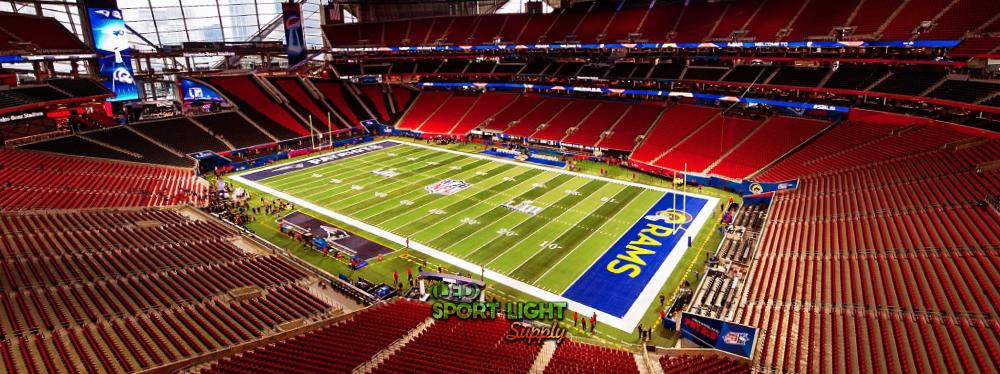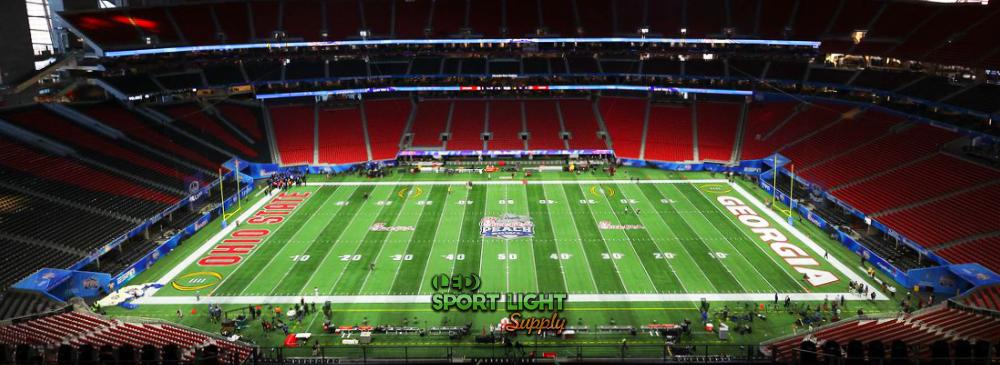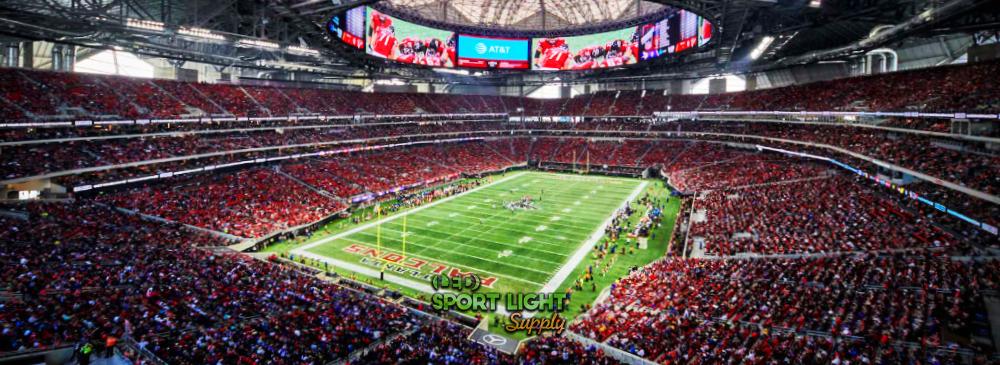The Super Bowl is not just a sporting event but a cultural spectacle that draws millions of viewers worldwide. While the game itself is the focal point, it’s the surrounding elements—especially the lighting—that enhance the experience, creating a visually engaging atmosphere that resonates with both live audiences and those watching from home. From pre-game excitement to halftime performances and post-game celebrations, lighting plays an integral role in shaping the event’s atmosphere, ensuring that every moment feels larger than life.
Table of Contents
ToggleLighting, in the context of the Super Bowl, serves two primary functions: it creates an atmosphere and ensures visibility. As a live broadcast event, lighting helps direct attention, creates visual effects, and facilitates the viewing experience, while also addressing practical needs like illumination for players and stadium security.
The Super Bowl is a showcase of extravagant visual effects, and lighting is at the heart of it. The large-scale production needs to captivate viewers right from the opening moments. A well-designed lighting setup, especially during halftime, complements the overall aesthetic and complements the performers, their costumes, and even the storyline of the show.
The lighting is carefully tailored to each segment of the event. For instance, in the halftime show, lighting design works hand-in-hand with the stage design and pyrotechnics to create a dramatic and immersive experience. The lighting is designed to highlight the performers, complement the set design, and add layers of visual excitement. For example, bright, vibrant hues can be used to evoke a sense of energy, while more subtle, softer lights create emotional depth. When combined with choreographed elements and costumes, the lighting creates a visual symphony that enhances the performance.
While aesthetics play a significant role, lighting also serves a practical function. During the game, visibility is paramount for both athletes and the cameras. Stadium lighting is strategically placed to ensure that the entire field is clearly visible, regardless of the time of day. Stadiums must be brightly illuminated to help players see the ball and one another, especially under tight game conditions.
In addition to the field, lighting helps the audience follow the action, ensuring that key moments, like touchdowns or game-changing plays, are easily visible from all angles. Broadcast lighting is similarly structured to complement camera shots, making sure the action is well-lit and properly framed on screen.
Moreover, lighting also shifts the ambiance throughout the event. For example, the lighting changes as the game progresses—from the excitement and thrill before the kickoff to the intensity during key moments and then to the celebration at the conclusion of the game.

As technology advances, so does the scale and sophistication of lighting systems. For the Super Bowl, lighting has become a fusion of artistry and innovation, with advancements such as LED technology, automated lights, and drones. Automated lighting systems allow for quick changes in color, intensity, and focus, giving lighting designers a high degree of flexibility to react to real-time events. Drones equipped with lights are also used to create stunning aerial visuals that add another layer of spectacle.
Lighting systems are also synchronized with sound, video projections, and pyrotechnics, making it easier to produce a seamless show. For example, the lighting may match the rhythm of the music during the halftime show or adjust during a dramatic play to enhance the moment. These technological innovations ensure that the audience’s attention is always directed where it matters most, whether it’s the action on the field or a pivotal moment in the performance.
The Super Bowl halftime show is one of the most-watched musical performances of the year, and lighting plays a central role in its execution. The challenge lies in designing a lighting scheme that complements the various performances and creates a captivating visual spectacle, all while working within a strict time frame.
Each Super Bowl halftime show is unique, often showcasing different musical genres and artists. Lighting must be customized to the specific needs of the performance, from stage setup to the choreography. The lighting needs to support the tone and energy of the performance. For example, an upbeat, high-energy performance may feature bright, flashing lights, while a slower ballad might rely on soft, warm colors to evoke a more intimate atmosphere.
Lighting designers must also ensure that the lights work in harmony with the stage design. The set itself may feature large screens, dynamic backdrops, or even moving elements, all of which require lighting adjustments to achieve the desired effect. Lights are carefully positioned to enhance these design elements, guiding the viewer’s focus to the most important aspects of the performance.
Color plays a vital role in lighting design for the Super Bowl. Warm colors like red, orange, and yellow are often used to create energy and excitement, while cooler colors such as blue and purple can evoke a sense of calmness or mystery. The intensity of the colors, the speed at which they change, and their contrast all work together to generate mood and emotion during the performance.
In addition to color, movement is another tool lighting designers use to enhance the visual impact. Dynamic lighting effects—such as strobes, sweeping beams, and changing intensities—add excitement and can sync with the rhythm of the music. These lights move in patterns that align with the choreography, drawing the audience’s attention to key moments. The lights also help create a sense of drama by highlighting specific performers or creating visual cues during moments of suspense.
Halftime lighting does not exist in isolation. It must work in tandem with other elements, such as pyrotechnics, sound, and video projections. To create a seamless performance, lighting must be synchronized with these elements to ensure smooth transitions and maintain energy levels throughout the show.
For example, during explosive moments in the performance, the lighting may sync with pyrotechnics to create an overwhelming sensory experience. Similarly, lighting can be timed to match dramatic shifts in the music or sudden changes in stage effects. This synchronization is achieved through a complex set of technical and creative planning, which requires constant communication between lighting designers, sound engineers, and performers.
While the Super Bowl’s stadium lighting is designed to enhance the game experience, it also provides an immersive environment for fans in the stands. A well-lit stadium elevates the excitement of the event, creating an atmosphere that resonates with the energy of the game.
Before the game begins, lighting is used to build anticipation. The pre-game show may feature elaborate light displays as the teams make their entrances, with spotlights and spotlights illuminating the players as they take to the field. The lighting is often coordinated with the national anthem or other ceremonial performances, adding gravitas to these moments and increasing the overall excitement.
In the lead-up to the game, bright lights may be used to focus attention on key moments, such as the unveiling of the Super Bowl trophy or the announcement of the teams. This type of lighting builds anticipation and provides an energizing prelude to the game itself.

Throughout the game, lighting plays a dual role: it enhances the atmosphere of the stadium and ensures that the action is visible from every angle. Floodlights and spotlights are used to create a bright, clear view of the field, enabling players and referees to see clearly even during night games. Additionally, the lighting setup ensures that the fans in the stadium can see the action clearly, regardless of where they are seated.
Beyond practicality, lighting helps elevate key moments in the game. For example, when a team scores a touchdown or wins the game, dramatic lighting effects can add to the celebratory atmosphere. Colorful, flashing lights and dynamic spotlights may be used to highlight significant moments, keeping the audience engaged and creating an overall sense of excitement.
While much of the lighting is designed to create a theatrical atmosphere, safety remains a priority. The lighting is carefully planned to ensure that the stadium is illuminated in a way that allows for easy movement of fans and staff, especially in the case of emergencies. Bright, well-placed lighting around the stadium ensures that exit routes are visible and easily identifiable, even in the dark.
Lighting is also essential for maintaining visibility during the game. During breaks or intermissions, lighting is adjusted to create clear views of the field while still maintaining a controlled atmosphere around the audience. These systems ensure that security personnel can maintain their visibility of the crowd, making the environment safe for all attendees.
| Lighting Equipment | Power Consumption (per unit) | Total Estimated Power Consumption | Purpose |
|---|---|---|---|
| LED Floodlights | 500W – 1kW | 500kW – 1MW | Used to illuminate the entire field, ensuring visibility and creating dramatic lighting effects |
| Automated Spotlights | 300W – 1.5kW | 100kW – 300kW | For precise lighting of players, performers, and key moments in the game |
| HMI Lights (High-Intensity) | 2kW – 5kW | 200kW – 500kW | Used for large-scale field illumination during gameplay and pre-game events |
| RGB LED Panels | 200W – 800W | 100kW – 300kW | Provide dynamic and colorful effects for stage shows, halftime, and player introductions |
| Strobe Lights | 500W – 1kW | 20kW – 50kW | Used during key game moments and halftime for visual impact and excitement |
| Laser Lights | 500W – 2kW | 10kW – 50kW | Create sharp, focused beams for dramatic effects during the halftime show and player celebrations |
Lighting a large-scale event like the Super Bowl is a complicated process, and designers face several challenges that require creative solutions. These challenges range from weather-related issues to ensuring that the lighting works seamlessly with the rest of the production.
One of the biggest challenges of lighting for the Super Bowl is the unpredictable weather. The Super Bowl is often held in outdoor stadiums, where weather conditions can change rapidly. For example, heavy rain, wind, or snow can affect lighting systems, causing delays or forcing last-minute adjustments. Lighting equipment must be durable enough to withstand these conditions, and backup systems must be in place to ensure the production continues smoothly if technical difficulties arise.
Lighting designers often need to prepare for these uncertainties by using weather-resistant lighting equipment and having backup plans in place. Additionally, outdoor stadium lighting needs to be designed in a way that minimizes shadows and ensures full coverage, despite any potential changes in weather.
Coordinating the lighting for an event as massive as the Super Bowl requires meticulous planning. Thousands of lights are used, each one requiring specific positioning and synchronization with other production elements like sound, video, and pyrotechnics. The logistics of setting up and managing these systems can be overwhelming, requiring a high level of precision and coordination among various teams.
Additionally, lighting needs to be adjusted during the game, from pre-game to halftime and then post-game. This requires careful scheduling and rehearsals to ensure the lighting transitions are smooth and effective. Given the size and complexity of the event, efficient communication between lighting designers, production teams, and performers is crucial.

Designing lighting that works for both in-stadium fans and those watching at home presents its own set of challenges. The lighting must be visible and effective for people in the stands, while also being clear and engaging for those watching on television. This requires understanding the differences between live viewing and broadcast viewing, ensuring that the lighting translates well across different mediums.
Broadcast lighting, for example, may require different angles, intensities, or color schemes to ensure that it complements the cameras’ framing and captures the action effectively. Stadium lighting must also maintain a balance between theatrical effects and visibility for the players, creating a cohesive experience for all.
Lighting not only enhances the physical environment but also significantly impacts the audience’s emotional experience. Whether at home or in the stadium, lighting plays a vital role in shaping how viewers perceive and engage with the event.
For television audiences, lighting plays a key role in enhancing the viewing experience. The lighting design is tailored to work with the cameras, ensuring that important actions are clearly visible and easy to follow. Broadcast lighting also contributes to the pacing of the event, with lighting shifts corresponding to changes in mood or intensity on the field.
During halftime, the lighting must work in conjunction with video projections and pyrotechnics to create an immersive experience for viewers at home. The use of color and movement can add an extra layer of engagement, helping to keep viewers excited and captivated throughout the show.
For fans in the stadium, lighting contributes to the overall atmosphere. From the bright lights that announce the start of the game to the dynamic effects during pivotal moments, lighting adds to the excitement and energy in the arena. Dramatic lighting effects can intensify the emotional connection between fans and the event, creating a shared experience that enhances their overall enjoyment.
| Lighting Equipment | Coverage Area | Field Coverage Percentage | Application at the Super Bowl |
|---|---|---|---|
| LED Floodlights | Entire field | 100% | Ensures even, high-intensity lighting across the whole stadium and field for visibility |
| Automated Spotlights | Specific sections of the field (e.g., end zones, key moments) | ~40% – 50% | Focuses on players, key action areas, and performers during transitions or significant plays |
| HMI Lights | Broad field areas and stadium sections | 70% – 80% | Primarily used for large-scale illumination across the field during play and events |
| RGB LED Panels | Stage, LED screens, surrounding stadium walls | 25% – 30% | Enhances visual effects during the halftime show and performances |
| Strobe Lights | Focused sections, primarily on action points | ~10% – 20% | Used in specific moments such as touchdowns or celebrations to add excitement and flair |
| Laser Lights | Stadium perimeter and stage area | ~10% – 15% | Highlight specific moments with focused beams, often used for dramatic effects at halftime |
Lighting ensures visibility for players, enhances the emotional intensity of key moments, and creates an immersive experience for both the live audience and television viewers. The use of advanced lighting technologies, from floodlights to dynamic LEDs and spotlights, highlights the scale and complexity of the event. The power consumption and strategic distribution of light across the stadium underscore the sophistication behind the design. As technology advances, future Super Bowls will continue to push the boundaries of lighting, elevating the visual and emotional impact of the event.
Drop us a line to receive a free lighting design